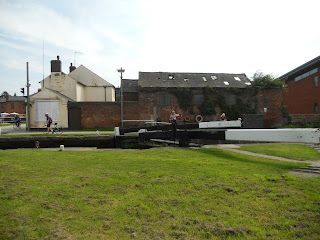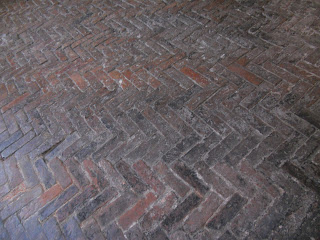I had planned on reading today, but it seemed like a waste of decent weather to stay inside all day long, so I headed over to the Cafe Afloat.
How cool is this--a cafe in a river barge on the canal?
I've been braver about crossing the locks, so set off on the shortcut Helen introduced to us last week. The canal was quite busy with barge activity today.
 | ||
| Notice the women at the locks |
 | |
| Note the barge captain at the back of the barge. |
 |
| The view from inside the barge. |
After taking bread back to the flat, I decided to take in the Commandery, a Worcester museum in our neighborhood.
Given the name and images associated with this museum, I was expecting a site devoted to the Civil War. It was so much more than that.
I took the audiophone to guide me through the museum and learned a lot about the multi-layered history of the home. There are six such layers at the home, beginning in 1085. Saint Wulfstan reportedly established a monastic hospital on or nearby the site, which was outside the city walls (it turns out Worcester was a walled city).
The building itself was home to a monastic hospital from 1455 to 1541 when Henry the VIII. The facility had five other iterations, or "layers" as the museum presented it.
Each room called on the visitor to press the room number and then a number associated with the iteration the visitor wanted to review on the audiophone device. The other "layers" were: Tudor home (1545-1607), Civil War (1642-1651), Georgian home (1714-1830), School for the Blind (1866-1888), and Littlebury Print Works (1888-1973). The museum came in to being in 1977.
None of the rooms contains furniture. Rather, the audio encourages the visitor to imagine the ways the house changed over time by sharing stories from each era.
The house was divided into "rich" and "poor" sections, as marked by a tiled floor versus a brick floor in a herringbone pattern.
I wasn't prepared for how long it would take to go through the six "layers' as I moved through each of the rooms, so I only got through the "rich" section of the house. I started by going in to a room where bodies were held before burial.
This is a funeral "pall" which was draped over the caskets of the departed. It was stitched together from bishop's vestments. This came from the Tudor era when the house was owned by Thomas Wylde, a clothing merchant. Clothing was a symbol of wealth, and merchants of clothing represented a major form of trade.
The stories on the audio service made the tour through the house very interesting and engaging, but as noted earlier, there was very little in the way of furnishings or accoutrement. This was one of the only data displays in the entire museum:
There seemed to be a real minimalist approach. Note the following:
 | ||
| This referred to a carved headboard from the Tudor era which became a fireplace frame during the Victorian age. |
 |
| This was a pocket worn tied to a women's waist (Georgian), in the era before pockets were integrated in to women's clothing. |
 |
| Yikes! |
The creepiest thing in the museum was this little beauty:
Fortunately, one has to enlarge the image of the placard to read the horrible post mortem of Oliver Cromwell. Discover at your own risk.
I didn't finish the audio tour and never got to the "poor" side as noted previously, primarily because the museum closed at 5:00 p.m.
I was able to stroll through the museum store for a short while before leaving and discovered some interesting World War II stuff:
My fingers were itching, but I stuck to my tschocke-free resolution.
I hadn't made my 10,000 steps for the day, so I took off on a bit of a walk. The first thing I saw was more canal activity.
I walked a bit through the city centre in hopes of finding a shop to sell me some jam for my toast, but I think the sidewalks roll up at 5:00 on Sundays.
I moved down to the river via the cathedral and noticed this sign, which had escaped me previously:
In one of the earlier blogs I wrote this past week I had cited the Swan statue along the river walk and I took note that it had been a gift from Worcester's "Twin"--Kleve, Germany. Now, I know the river walk is called Kleve Walk. I've been walking back and forth from Helen and Kathryn's along the canal and crossing the locks. When coming home after dark, there are some really dark parts (meaning I have to buy myself a "torch"/flashlight), but when I come to the river--excuse me, Kleve Walk, it's lit quite thoroughly. Just before I got to my flat, I saw this sign:
As I made my way home this evening, I heard people describe this as an issue of safety versus aesthetics. I know I am grateful for the light, but I appreciate the sentiment in the sign. Life's never simple, eh?




















No comments:
Post a Comment